VATICAN MUSEUMS (SISTINE CHAPEL)
In the Vatican Museums, you will find the world’s largest and most important art collection, which includes masterpieces from ancient times. These include masterpieces ranging from ancient Egypt to ancient Greece to ancient Rome, from early Christian and medieval art to the Renaissance, and from modern art to contemporary art from the 17th century.
In the Vatican Museums, there’s an incredible collection of frescoes, paintings, mosaics, sculptures, and statues created by great artists and gathered by popes over the centuries.
Vatican museums have 54 museums and 70,000 pieces, of which 20,000 live on display, and are spread over 1400 rooms, chapels, and galleries. They are a symbolic place where cultures and religions meet and hold extraordinary collections of art, beauty, and history.
vatican museums rome
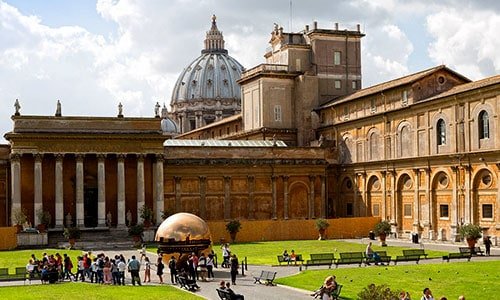
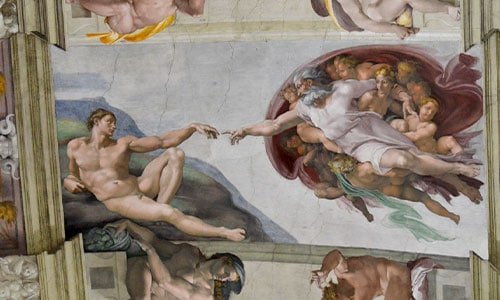
Pope Sixtus IV started building the famous Sistine Chapel in 1470, commissioning top Renaissance artists like Botticelli and Perugino to decorate it. The frescoes on the walls were made by them.
It is believed that Pope Julius II Della Rovere is the one who really founded the Vatican Collections, cramming his large private collection of classical sculptures into the Courtyard of Statues, today’s Cortile Ottagono, in 1506, with significant changes.
Afterward, he added more works to the palace by buying the most famous ancient sculptures of the time to create the Cortile del Belvedere, which he entrusted to Donato Bramante.
A major event in 1508 was Pope Julius II‘s commission of Michelangelo to decorate the ceiling of the Sistine Chapel with Old Testament facts and characters.
Under the pontificate of Clement VIII, Taddeo Landini completed the building, which contains the magnificent Sala Clementina, decorated by Giovanni and Cherubino Alberti and Paolo Bril. The Gallery of Maps was built on the west side of the Belvedere Courtyard in 1580 by Pope Gregory XIII.
In 1807, Antonio Canova started building the Chiaramonti Museum, which consists of the Chiaramonti Gallery, the Lapidary Gallery, and the Braccio Nuovo. In 1837, Pope Gregory XVI opened the Etruscan Museum with finds from Etruscan excavations, and in 1839, the Egyptian Museum with finds from Egyptian excavations.
The Palazzetto del Belvedere (now part of the Pio-Clementino Museum) was reserved for the admiration of masterpieces of art by artists, nobles, and scholars. During the reign of Pope Clement XIV, The Vatican Museums opened to the general public in 1771.
You can buy st peter’s basilica Vatican tickets from here
You can book st peter’s basilica and Sistine chapel tour from here
vatican museums must see
Through the centuries, the Vatican Museums have represented the environments of the popes who followed one another. There are some of the world’s greatest Renaissance masterpieces and some of the most famous Roman sculptures in the immense collection accumulated by the Roman Catholic Church.
Picture gallery of the Vatican
There are 18 large rooms in the Vatican Pinacoteca, one of Europe‘s most important art galleries, where you can admire masterpieces from the eleventh to nineteenth centuries. Naturally, the majority of space is dedicated to the Renaissance and its artists.
A new art gallery created by the architect Luca Beltrami with works ranging from the Middle Ages to the 1800s was inaugurated by Pope Pius XI in 1932 to enhance and share the pope’s enormous historical and artistic heritage.
As the collection grew, donations from private individuals and purchases reached today’s nucleus of 460 canvases divided chronologically and by the school, ranging from the so-called Primitives of the twelfth to the nineteenth century.
There are some great artists whose masterpieces are present in the collection, who are considered to be among the finest in the history of Italian art: Giotto , Beato Angelico , Perugino , Pinturicchio , Raffaello , Giovanni Bellini , Leonardo , Tiziano , Veronese , Caravaggio , Peter Wenzel and the tapestries of Pieter van Aelst.
Pio-Clementino Museum
In the year 1771, Pope Clement XIV founded this museum in order to preserve the art of the time. From 1775 to 1799 it was expanded by his successor Pius VI, who founded the museum with the intention of enhancing and promoting the most important Greek and Roman works of art that were held in the Vatican.
It has fourteen exhibition rooms, making it the biggest Vatican museum. There are two levels: works and archaeological finds from the third century BC to the nineteenth century. Some of the most famous statues are Apollo del Belvedere, a Roman bronze copy based on the Greek original, possibly made by Leochares (330-320 BC), and Apoxyomenos (1st century AD), made from an original bronze by Lysippus (third quarter of 4th century BC).
A sculptural group of Laocoonte found in 1506 among the ruins of the Baths of Titus in Rome is the museum’s most famous work. It is a Roman copy of a Greek bronze original found two centuries earlier, by Aghesandro, Polydoro, and Athenodoro from Rhodes.
Pio Cristiano Museum
A collection of statues and sarcophagi dated between the 2nd and 5th centuries AD is on display in the Pio Cristiano Museum. This museum used to house papal residences until 1304. It was founded in 1854 by Pope Pius IX, who decided on the construction following the start of the excavations undertaken by the Commission for Sacred Archeology in 1853.
There are two large sections of the museum: one devoted to architectural monuments, sculptures, and mosaics, and the other devoted to epigraphic material from various eras and topics.
Among the most famous archaeological finds of the Pio Cristiano Museum is the “Good Shepherd with lamb” statue, produced by an anonymous sculptor between 300 and 350 AD. It is the oldest representation of Christ in the world, found in the Catacombs of San Callisto.
Sistine Chapel
Pope Sixtus IV Della Rovere had the Sistine Chapel built using the foundations and walls of the old Cappella Magna, a fortified hall from the Middle Ages. This is one of the chapels of the Apostolic Palace. Architect Baccio Pontelli aimed to make use of the medieval walls up to a third of their height in his project.
The frescoes on the walls depicted oriental scenes from the life of Jesus and Moses, respectively. These paintings were created by Renaissance masters such as Sandro Botticelli, Pietro Perugino, Domenico Ghirlandaio, Cosimo Rosselli, and Luca Signorelli.
Michelangelo Buonarroti painted the vault of the chapel between 1508 and 1512, commissioned by Pope Julius II, representing important Old Testament and New Testament episodes.
The most famous and iconic scene is “The Creation of Adam,” which is often reproduced. Demonstrate how God touched Adam with his outstretched finger to give him life. 520 square meters of frescoes depicted scenes from Genesis and contained 115 real characters. The frescoes were first displayed to the public in November 1512.
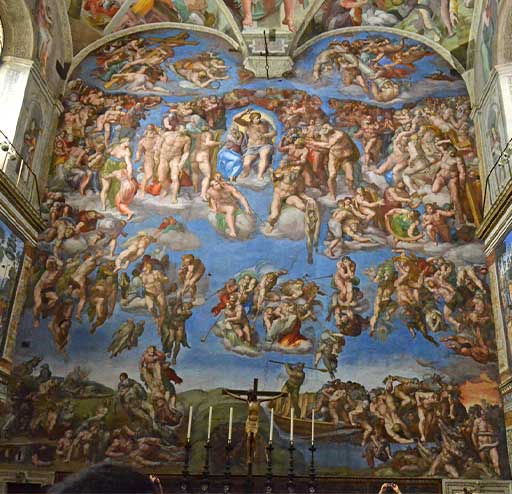
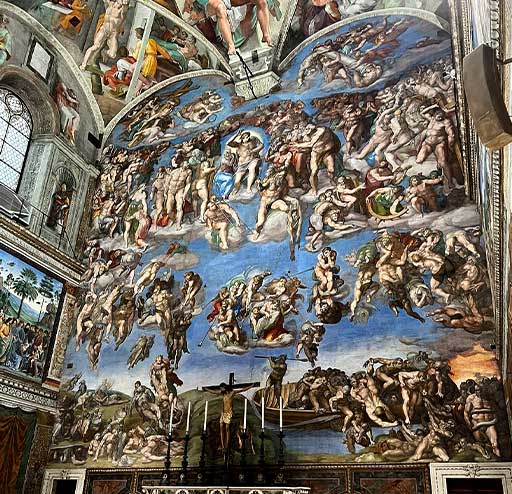
Raphael’s Rooms
The Raphael Rooms have drawn millions of visitors annually, similar to the iconic scene on the roof of the Sistine Chapel.
The Raphael’s Rooms are four separate rooms in the Palace of the Vatican and were part of the apartment of Pope Julius II (pontiff from 1503-1513). The walls of each room are covered with immense frescoes depicting religious and mythological stories. These rooms were designed by Raphael himself and named after him.
Many artworks were painted by Raphael. Due to the artist’s unexpected death in 1520, many of the rooms had to be completed by the students of the School of Raphael. There is a symphony of exquisite artworks decorating the interior walls and ceilings, alluding to a significant aspect of the Christian faith.
The Room of Constantine
Receptions and official ceremonies were held in the Room of Constantine. A majority of the artwork in this room was completed by the School of Raphael, based on drawings by the recently deceased artist. In honor of Constantine, the first Christian Emperor to recognize the Christian faith, the room was named after him.
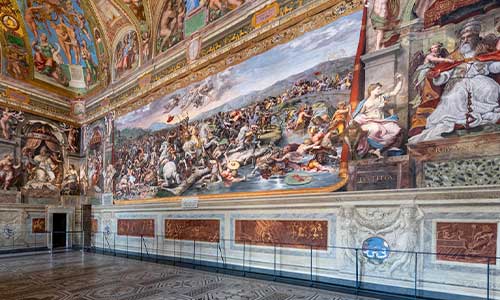
The Room of Segnatura
This room contains some of Raphael‘s most famous works and marks the artist’s first involvement with the Vatican. A Renaissance theme is reflected in the artworks by depicting the beginning of the Renaissance. In the past, the Pope headed the Segnatura Gratiae et Lustitiae, which was the highest court of the Holy See.
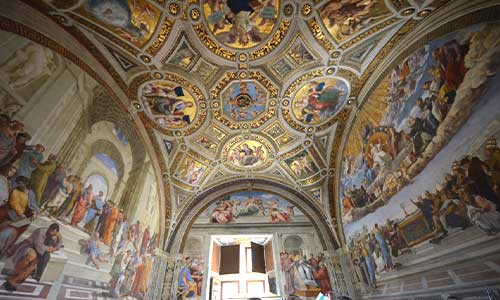
The Room of Heliodorus
Raphael immediately began painting the Room of Heliodorus after completing the Room of Segnatura. This room was originally used by the Pope for private audiences, but the artwork in the room depicts a more political perspective. One of Raphael‘s paintings depicts the story of a traveling priest who doubted that the bread and wine at mass could become the body and blood of Christ.
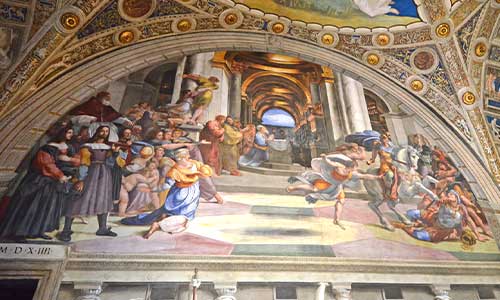
The Room of the Fire in the Borgo
The Room of Fire is named after the most famous fresco in the Borgo, the “Fire in the Borgo“. The story tells of Pope Leo IV putting out a huge fire simply by making the sign of the cross. A dramatic image shows people frantically putting out the fire and trying to rescue those trapped inside. As Pope Leo stands calmly on a balcony, people below pray to him, demonstrating their devotion and trust in him.
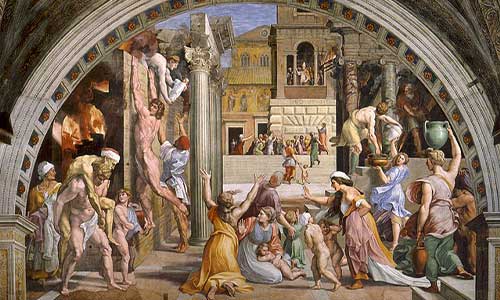
The Vatican Museums and Sistine Chapel Opening and Closing Calendars for 2022 can be downloaded here
Vatican museums ticket price
The cost of the basic ticket is 17 €.
The price for children aged between 6 and 18 is 8 €. Kids below 6 years old enter for free and do not need ticket reservations.
The cost of the online reservation (which would have been € 4) is canceled for the entire period following the reopening of the closure of the Coronavirus pandemic.
More information is available on the Vatican Museums’ official website
Visit the Vatican Museums – 2025
USEFUL INFORMATION
Opening days and times 2025
St Peter’s – daily 7.00 am-7.00 pm April to September, 7.00 am-6.00 pm October to March.
St Peter’s Dome – daily 8.00 am-6.00 pm April to September, 8.00 am-5.00 pm October to March.
The Treasury – daily 9.00 am-6.15 pm April to September, 9.00 am-5.15 pm October to March.
Grottoes – daily 7.00am-6.00pm April to September, 7.00am-5.00pm October to March
Museums – Monday-Saturday 9.00am-6.00pm, last entrance: 4.00pm.
Free entrance on the last Sunday of every month, admission 9.00 am-12.30 pm. Museums close at 2 pm
The museum entrance closes 75 minutes before closing time
Standard tickets from €17
How to get there
By Metro
Line A stations: Ottaviano – S.Pietro-Musei Vaticani, Cipro
By bus
49: stop in front of the museum entrance
32, 81, 982: Piazza del Risorgimento
492, 990: Via Leone IV / Via degli Scipioni
By tram
19: Piazza del Risorgimento
By taxi
Taxi stand: Viale Vaticano in front of the museum entrance
Book online
Visiting the Vatican tips
- It is best to book in advance. Although you can show up on the day and queue, many people do, but knowing you have planned ahead will make you feel more relaxed.
- If possible, use an audio guide or a guidebook, or better yet, hire a tour guide. There are so many incredible treasures in the Vatican Museum that you would definitely benefit from a guide of some sort.
- It is quietest in the early mornings and late afternoons, except on Wednesday mornings when the Pope holds his audience.
- Fast-track tickets may not be available on the day you want, so check the tickets that include the audio guide or tour tickets.
- When you combine the Vatican Museums with St Peter’s Basilica, plan to spend a whole day at the Vatican. You can easily spend an entire day exploring.
vatican museums dress code
Please do not wear clothing that is inappropriate. It is likely that you will be turned away. There will be no shorts, no sleeveless tops, no skirts that do not cover the knees, and no hats allowed.
